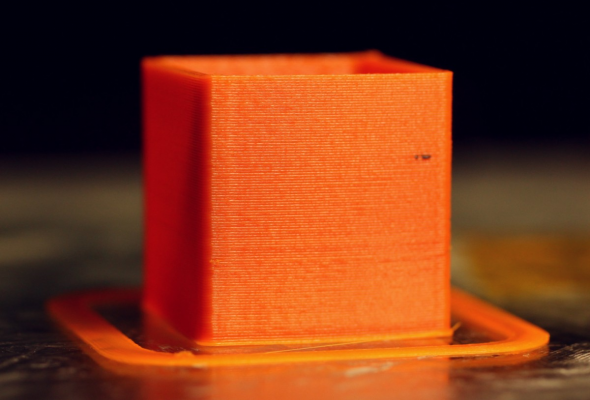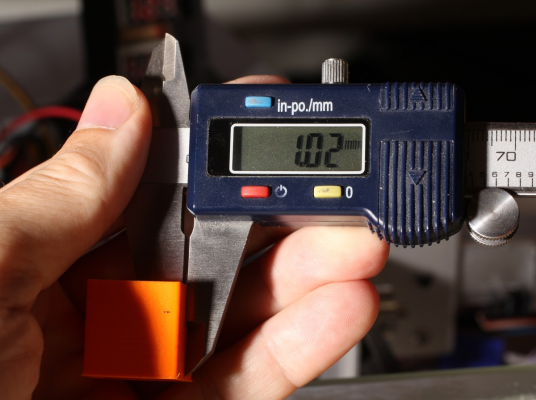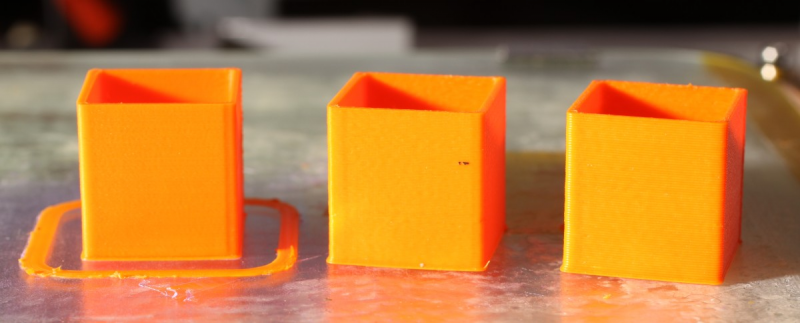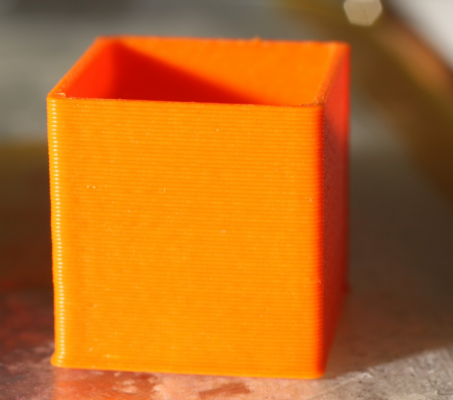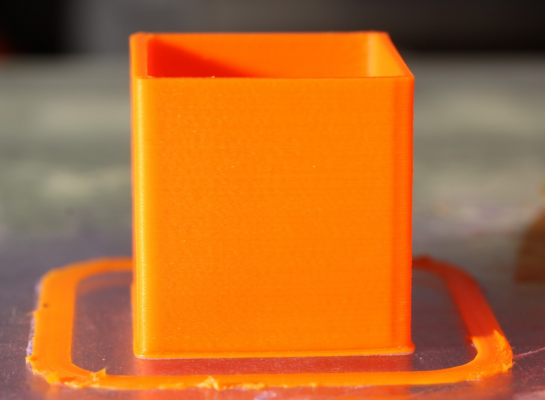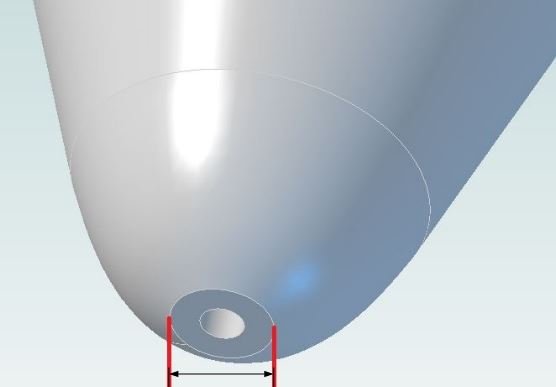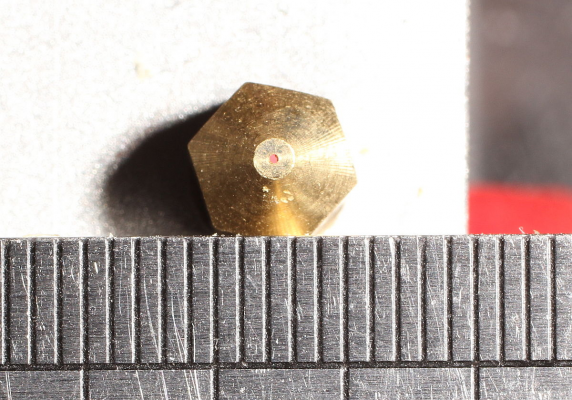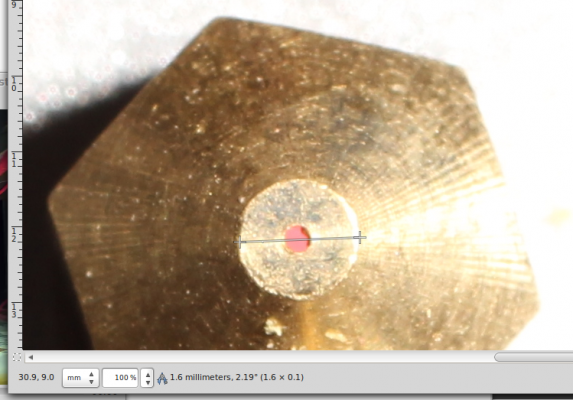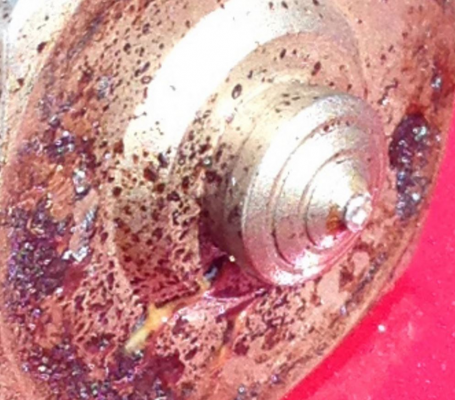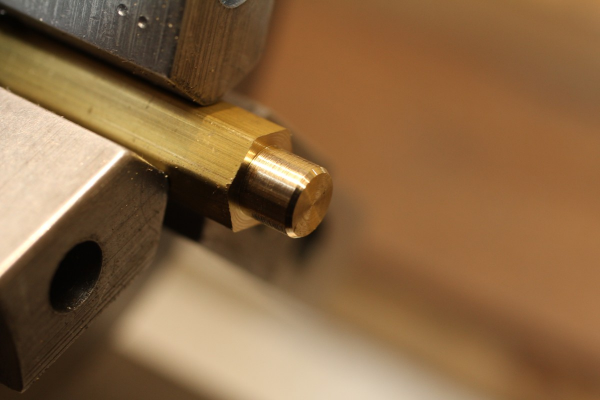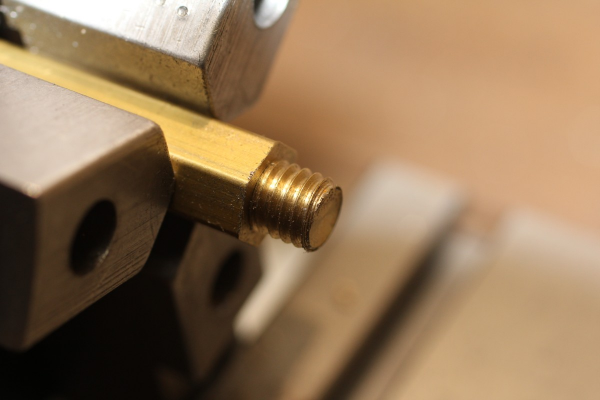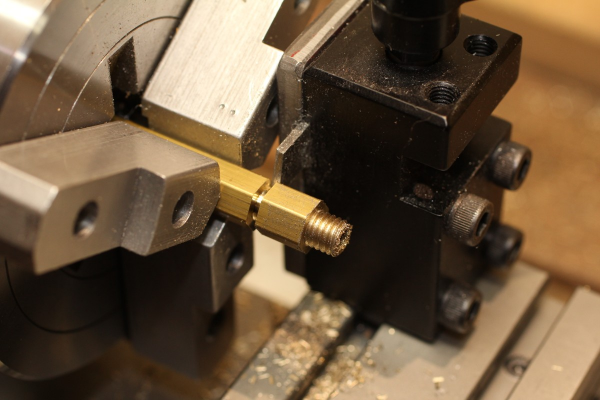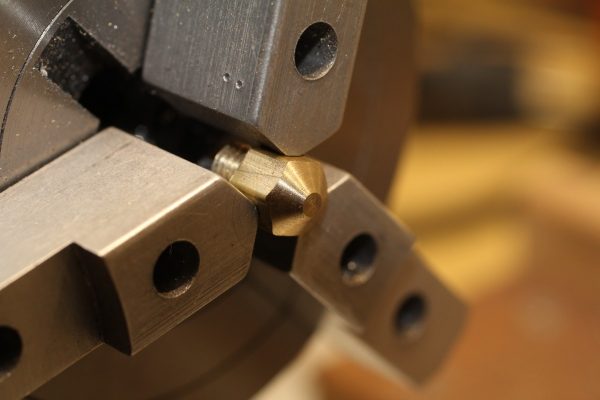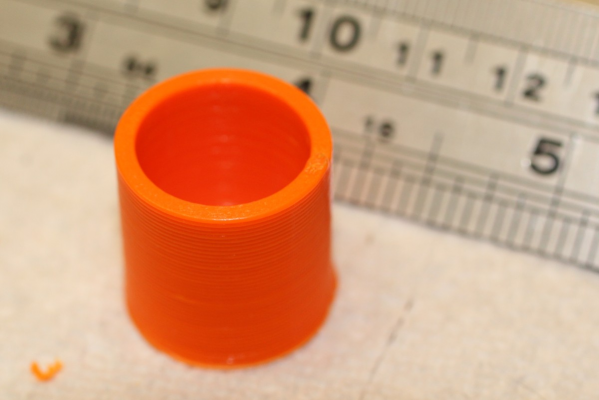Printing at 2.5 x nozzle size
Posted by JamesK
|
Printing at 2.5 x nozzle size October 08, 2016 10:19PM |
Registered: 9 years ago Posts: 1,873 |
Hi,
So in another thread I said that I had printed at 2x nozzle size fairly regularly without problems and some doubts were cast as to whether the results would be sufficiently accurate. Seeing as I've just been doing some print calibration tests I thought it would be easy enough to run off a quick test cube to check I wasn't spreading bad information.
Here's a single walled cube printed using 1mm width from a 0.4mm nozzle for a nozzle to extrusion multiplier of 2.5X. Printed with 3mm ABS and 0.2mm layer thickness.
Not claiming it's the best print in the world, but it's certainly usable.
So in another thread I said that I had printed at 2x nozzle size fairly regularly without problems and some doubts were cast as to whether the results would be sufficiently accurate. Seeing as I've just been doing some print calibration tests I thought it would be easy enough to run off a quick test cube to check I wasn't spreading bad information.
Here's a single walled cube printed using 1mm width from a 0.4mm nozzle for a nozzle to extrusion multiplier of 2.5X. Printed with 3mm ABS and 0.2mm layer thickness.
Not claiming it's the best print in the world, but it's certainly usable.
|
Re: Printing at 2.5 x nozzle size October 09, 2016 06:53AM |
Registered: 8 years ago Posts: 155 |
Very interesting. I really want to know more about it, also hear the explanation from other people baout tech issues here. My knowledge is restricted to what I have learnt on the net reading tech articles and from printing experience. Since now the max (safe) width for an extrusion should be noozle size X 1.7, so for a 0.4 noozle we should print at a max of 0.68. Going beyond that should take us into a zone where curling at the borders of the extrusion can happen.
Im very interested alo because of speed: havening such an extrusion of 1 mm would give a very strong piece with just a single pass!!!! great!
Can you measure the hole wall? I mean put the caliper covering from the bottom to the top so it measures the average width to see if the 1 mm is even or in fact there is curling and un eveness? Do you notice? curling on the edge of the last layer? What hotend do you have? printing speed? can you make the same at 0.1, 0.3 layers?
Material used? if PLA, can you do the same with ABS?
Thanks for shareing!
Im very interested alo because of speed: havening such an extrusion of 1 mm would give a very strong piece with just a single pass!!!! great!
Can you measure the hole wall? I mean put the caliper covering from the bottom to the top so it measures the average width to see if the 1 mm is even or in fact there is curling and un eveness? Do you notice? curling on the edge of the last layer? What hotend do you have? printing speed? can you make the same at 0.1, 0.3 layers?
Material used? if PLA, can you do the same with ABS?
Thanks for shareing!
|
Re: Printing at 2.5 x nozzle size October 09, 2016 08:54AM |
Registered: 9 years ago Posts: 1,873 |
Hi Tinchus,
Yes, part strength was one of the reasons I initially started using such wide extrusion. It gives very good layer to layer adhesion which helped with de-lamination problems I was having with ABS. It's also convenient sometimes to be able to choose between two .5mm paths or a single 1mm path on a 1mm feature.
The print looks about as even as most of my other test cubes at smaller widths. I think most of the errors come from too much flex in the 8mm smooth rods - the next build is hopefully going to be a lot stiffer. No noticeable edge curling on this print as long as the part fans are running (the latest build of Slic3r isn't processing the cooling settings properly, so the first print failed due to too much heat build-up).
I make my own hotends, roughly along the lines of the E3d V6. The nozzle is a cheap Chinese one. This printed at 20mm/s although it would have been slower if the cooling settings were working - I set a minimum 10s layer time, and this was running at about 5s per layer. Good questions about .1 and .3 layer thickness, I'll have to try. I think that layer heights around 1/2 the nozzle diameter is about the sweet spot for ease of printing, so I suspect that as you move away from that it may get more difficult to get consistent results. I'll try the different heights when I get a chance, and also get that measurement you asked about.
Material was ABS, but I've printed wide with pla, petg and nylon in the past.
Regards,
Yes, part strength was one of the reasons I initially started using such wide extrusion. It gives very good layer to layer adhesion which helped with de-lamination problems I was having with ABS. It's also convenient sometimes to be able to choose between two .5mm paths or a single 1mm path on a 1mm feature.
The print looks about as even as most of my other test cubes at smaller widths. I think most of the errors come from too much flex in the 8mm smooth rods - the next build is hopefully going to be a lot stiffer. No noticeable edge curling on this print as long as the part fans are running (the latest build of Slic3r isn't processing the cooling settings properly, so the first print failed due to too much heat build-up).
I make my own hotends, roughly along the lines of the E3d V6. The nozzle is a cheap Chinese one. This printed at 20mm/s although it would have been slower if the cooling settings were working - I set a minimum 10s layer time, and this was running at about 5s per layer. Good questions about .1 and .3 layer thickness, I'll have to try. I think that layer heights around 1/2 the nozzle diameter is about the sweet spot for ease of printing, so I suspect that as you move away from that it may get more difficult to get consistent results. I'll try the different heights when I get a chance, and also get that measurement you asked about.
Material was ABS, but I've printed wide with pla, petg and nylon in the past.
Regards,
|
Re: Printing at 2.5 x nozzle size October 09, 2016 10:51AM |
Registered: 9 years ago Posts: 1,873 |
OK, here's the measurement over more of the height. I have my Z0 set a little low to squish the first layer to improve bed adhesion, so that one is wider than the rest. I didn't include it in the measurement, but if I had it would be about 1.4 to 1.5mm.
Depending on where I measure results ranged between about 0.9 and 1.04mm.
Here are the three cubes at 0.1, 0.2 and 0.3mm layer heights
The 0.3mm version is starting to show signs of poorly constrained extrusion, and is a little rough and ready. Still usable for functional parts though.
The 0.1mm print looks pretty good, except that the smoother finish shows up the positioning/harmonic errors on the corners. The measurements also show another problem, at this layer height the walls show greater differences in thickness, with one wall measuring approx 0.9mm, one about 1.1mm and the other two closer to 1.0. The increased width to height ratio seems to accentuate any asymmetry in the nozzle.
Depending on where I measure results ranged between about 0.9 and 1.04mm.
Here are the three cubes at 0.1, 0.2 and 0.3mm layer heights
The 0.3mm version is starting to show signs of poorly constrained extrusion, and is a little rough and ready. Still usable for functional parts though.
The 0.1mm print looks pretty good, except that the smoother finish shows up the positioning/harmonic errors on the corners. The measurements also show another problem, at this layer height the walls show greater differences in thickness, with one wall measuring approx 0.9mm, one about 1.1mm and the other two closer to 1.0. The increased width to height ratio seems to accentuate any asymmetry in the nozzle.
|
Re: Printing at 2.5 x nozzle size October 09, 2016 07:11PM |
Registered: 8 years ago Posts: 155 |
|
Re: Printing at 2.5 x nozzle size October 10, 2016 04:31AM |
Registered: 10 years ago Posts: 580 |
That's a nice test James.
Can you do me a favor and measure the approximate diameter of the flat area at the tip of the nozzle? Not easy I know...
I've been guessing that this 1.7x factor was determined using one particular nozzle geometry, and a pointier nozzle with less flat area may fare worse (start curling sooner) than a broader nozzle tip when printing wide.
My printer: Raptosaur - Large Format Delta - [www.paulwanamaker.wordpress.com]
Can you answer questions about Calibration, Printing issues, Mechanics? Write it up and improve the Wiki!
Can you do me a favor and measure the approximate diameter of the flat area at the tip of the nozzle? Not easy I know...
I've been guessing that this 1.7x factor was determined using one particular nozzle geometry, and a pointier nozzle with less flat area may fare worse (start curling sooner) than a broader nozzle tip when printing wide.
My printer: Raptosaur - Large Format Delta - [www.paulwanamaker.wordpress.com]
Can you answer questions about Calibration, Printing issues, Mechanics? Write it up and improve the Wiki!
|
Re: Printing at 2.5 x nozzle size October 10, 2016 07:11AM |
Registered: 9 years ago Posts: 1,873 |
Quote
Paul Wanamaker
I've been guessing that this 1.7x factor was determined using one particular nozzle geometry, and a pointier nozzle with less flat area may fare worse (start curling sooner) than a broader nozzle tip when printing wide.
Yes, that sounds like a reasonable theory. I've been meaning to make some of my own nozzles and one of the things I want to try is a nozzle with an oversized flat on the tip. I want to see what the limitations of a very flat tipped nozzle are, beyond the obvious practical issues of limited max extrusion speed from the bore vs the volume needed for a wide extrusion. My gut feeling is that the current nozzles running with max extrusion width of around 2x bore are probably in the sweet spot for usability, but it would be interesting to know if the slicers could make more use of variable width extrusion if they had a configurable upper limit.
I'll try and get that measurement for you later today.
|
Re: Printing at 2.5 x nozzle size October 10, 2016 08:21AM |
Registered: 12 years ago Posts: 2,470 |
Flat tipped nozzles are easier to produce with a precise hole than sharp tipped ones. In my tests i found that it is just the quality of the nozzle opening that determines how far you can go beyond the original diameter. Any imprecision means that the filament will not extrude straight, which leads to curling.
Over all i found that the airbursh nozzles i use with the Merlin hotend tend to work very well. They are sharp tipped, but precisely manufactured. They are easy to damage though if you run them against anything.
[www.bonkers.de]
[merlin-hotend.de]
[www.hackerspace-ffm.de]
Over all i found that the airbursh nozzles i use with the Merlin hotend tend to work very well. They are sharp tipped, but precisely manufactured. They are easy to damage though if you run them against anything.
[www.bonkers.de]
[merlin-hotend.de]
[www.hackerspace-ffm.de]
|
Re: Printing at 2.5 x nozzle size October 10, 2016 08:28AM |
Registered: 8 years ago Posts: 413 |
thanks james - good info.
I think some of these factors are historical but remain good rules of thumb.
The slicer maths probably starts to become a bit inaccurate with certain combinations of parameters as does the machine limits.
The other rule is to limit layer height to 0.8 of diameter. Again a sensible number to avoid extreme combinations.
I suspect it avoids specifying wide widths and large layers that drive issues with, feed rate, heating rate and nozzle profile.
I would have expected more issues with corner profiles as you are effectively over extruding so the filament can go in any direction
I think some of these factors are historical but remain good rules of thumb.
The slicer maths probably starts to become a bit inaccurate with certain combinations of parameters as does the machine limits.
The other rule is to limit layer height to 0.8 of diameter. Again a sensible number to avoid extreme combinations.
I suspect it avoids specifying wide widths and large layers that drive issues with, feed rate, heating rate and nozzle profile.
I would have expected more issues with corner profiles as you are effectively over extruding so the filament can go in any direction
|
Re: Printing at 2.5 x nozzle size October 10, 2016 09:17AM |
Registered: 9 years ago Posts: 1,873 |
Here are the measurements on the nozzle (not actually the one in use, but another from the same order).
The flat measures 1.56mm, the nozzle bore (nominally 0.4) measures .35mm, so this nozzle has an unusually large ratio of about 4.5:1. I made the measurements photographically, using shims to hold a ruler in the plane of the nozzle and then taking measurements in gimp. The ruler is there to provide a calibration reference from mm to pixels.
Edited 2 time(s). Last edit at 10/10/2016 09:20AM by JamesK.
The flat measures 1.56mm, the nozzle bore (nominally 0.4) measures .35mm, so this nozzle has an unusually large ratio of about 4.5:1. I made the measurements photographically, using shims to hold a ruler in the plane of the nozzle and then taking measurements in gimp. The ruler is there to provide a calibration reference from mm to pixels.
Edited 2 time(s). Last edit at 10/10/2016 09:20AM by JamesK.
|
Re: Printing at 2.5 x nozzle size October 10, 2016 03:00PM |
Registered: 10 years ago Posts: 580 |
Fascinating.
Excellent photos, that really helps. I think that closeups like that, along with extreme closeups of the extrusion is the best way to determine what is really happening.
The one Stratasys nozzle I've seen was this one from a mostly bad support nozzle from the Milwaukee Maker Space
The geometry was the opposite of what I mocked up above. Theirs is very pointy with almost no material around the bore.
I can see that it my wear out much quicker because of that, but is there some other good reason for having it that way? Perhaps it does not touch the surroundings as much. I wonder if their main nozzle is the same? I think the only good way to know is to test, with clear photos of the results.
I hope you don't mind me listing my questions about what makes the perfect nozzle geometry:
My printer: Raptosaur - Large Format Delta - [www.paulwanamaker.wordpress.com]
Can you answer questions about Calibration, Printing issues, Mechanics? Write it up and improve the Wiki!
Excellent photos, that really helps. I think that closeups like that, along with extreme closeups of the extrusion is the best way to determine what is really happening.
The one Stratasys nozzle I've seen was this one from a mostly bad support nozzle from the Milwaukee Maker Space
The geometry was the opposite of what I mocked up above. Theirs is very pointy with almost no material around the bore.
I can see that it my wear out much quicker because of that, but is there some other good reason for having it that way? Perhaps it does not touch the surroundings as much. I wonder if their main nozzle is the same? I think the only good way to know is to test, with clear photos of the results.
I hope you don't mind me listing my questions about what makes the perfect nozzle geometry:
- What is the effect of a soft or rounded transition zone from the flat bottom to the outside of the nozzle?
- What is the effect of a sharp corner there instead?
- What are the effects of the nozzle touching (or from the nozzles perspective: colliding with) other previously extruded (and possibly cool) perimeters: vibration, smoothing of the top surface, vertical or horizontal deviation, smearing?
- For nozzles with a narrow tip area - what is the upper limit for extrusion width before something bad happens? What does the "bad" that happens look like close up?
- Is it beneficial or not for the inner orifice corner to be very slightly rounded (and you are printing at > than that diameter).
- What is the relationship between print speed, extrusion width, and layer height when printing wide. For example: If you were printing at .2mm layer height at 20mms, 1 mm wide, vs .1mm layer height at 40mms. I would expect at some point the outside edges of the extrude to become ragged overlapping plates, rather than smooth and well bonded. I'm imagining this process in slow motion... If the extruder and hot end were not over taxed then I would expect the same effect by just increasing the print speed.
- After understanding/testing the above, is there a sweet spot, say 3x or 4x? of the particular orifice diameter that would give the cleanest print while also allowing wide extrusion?
My printer: Raptosaur - Large Format Delta - [www.paulwanamaker.wordpress.com]
Can you answer questions about Calibration, Printing issues, Mechanics? Write it up and improve the Wiki!
|
Re: Printing at 2.5 x nozzle size October 10, 2016 03:48PM |
Registered: 8 years ago Posts: 155 |
Your noozle tip has a big flat area indeed, now I understand better your good results beyond the 1.7 rule. I would like to see if it is posible another test: Overhangs.
The reason of haveing small flat areas around the hole, not my knowledge but what I read in the net, is that that is the way to reduce heat radiation to the plastic lines in the neighbour perimeter.
Can you make and overhang test starting at 45 degrees and going to something like 20? Useing BAS if posible, so no cooling
The reason of haveing small flat areas around the hole, not my knowledge but what I read in the net, is that that is the way to reduce heat radiation to the plastic lines in the neighbour perimeter.
Can you make and overhang test starting at 45 degrees and going to something like 20? Useing BAS if posible, so no cooling
|
Re: Printing at 2.5 x nozzle size October 10, 2016 04:15PM |
Registered: 9 years ago Posts: 1,873 |
Great set of questions Paul. Another one I've wondered about is if polishing/coating the nozzle would make a difference. Srek mentioned (a while ago in another thread) that the merlin nozzles are particularly good at bridging, so like Tinchus mentioned the ability of different nozzle shapes to cope with the less constrained printing scenarios like bridging and overhangs is also worth looking into. Now all we need is lots of spare time!
|
Re: Printing at 2.5 x nozzle size October 10, 2016 06:18PM |
Registered: 9 years ago Posts: 1,873 |
I accidentally made a 1.2mm nozzle (trying for 0.8, broke the drill, rescued it with the smallest drill I had left), and the thing is hilarious to use. It's like printing with a sausage machine 
My poor little nema 14 extruder struggles to keep up, as this thing just eats filament. The limit is somewhere between 20 and 33 mm3/s, and I think is rate limited by the heater block. I took a few photos as I was making it, here I've just turned down the back for the m6 thread
then threaded...
drilled and reamed 3.5mm and starting to part off
and finally with the tip turned and ready for me to break the 0.8mm drill
Strangely, thinking I'd written off the morning's work, I didn't take any more photos after that, but I managed to rescue it by flipping it around and drilling back through with a bigger drill. I've just been trying it out and it's going to take some fine tuning of the settings as it's so different to the smaller nozzles. The large volume of plastic seems to hold onto heat a lot more and is visibly soft and elastic as higher layers are going on. Part strength and layer bonding is amazing! Here's a 20mm single wall cylinder with 0.5mm layers and a 2mm thick wall printed in spiral vase mode
It's odd, the wall measures about 1.9mm, suggesting under extrusion, but 100% infill on the first few layers of other tests looks very over extruded. More investigation needed. I'm not completely convinced that single wall thickness is a good indicator of correct extrusion.

My poor little nema 14 extruder struggles to keep up, as this thing just eats filament. The limit is somewhere between 20 and 33 mm3/s, and I think is rate limited by the heater block. I took a few photos as I was making it, here I've just turned down the back for the m6 thread
then threaded...
drilled and reamed 3.5mm and starting to part off
and finally with the tip turned and ready for me to break the 0.8mm drill

Strangely, thinking I'd written off the morning's work, I didn't take any more photos after that, but I managed to rescue it by flipping it around and drilling back through with a bigger drill. I've just been trying it out and it's going to take some fine tuning of the settings as it's so different to the smaller nozzles. The large volume of plastic seems to hold onto heat a lot more and is visibly soft and elastic as higher layers are going on. Part strength and layer bonding is amazing! Here's a 20mm single wall cylinder with 0.5mm layers and a 2mm thick wall printed in spiral vase mode
It's odd, the wall measures about 1.9mm, suggesting under extrusion, but 100% infill on the first few layers of other tests looks very over extruded. More investigation needed. I'm not completely convinced that single wall thickness is a good indicator of correct extrusion.
|
Re: Printing at 2.5 x nozzle size October 10, 2016 11:21PM |
Registered: 12 years ago Posts: 799 |
how will the print quality result when printing other stuff like figures, parts with overhangs non 90° vertical angles, non straight uniformly parts ?
Chri
[chrisu02.wordpress.com] Quadmax Intel Delid Tools
Chri
[chrisu02.wordpress.com] Quadmax Intel Delid Tools
|
Re: Printing at 2.5 x nozzle size October 11, 2016 08:24AM |
Registered: 9 years ago Posts: 1,873 |
Quote
Chri
how will the print quality result when printing other stuff like figures, parts with overhangs non 90° vertical angles, non straight uniformly parts ?
Chri
Badly I expect, as the greater distance the molten filament has to travel then presumably the greater chance there is for errors in the final position of the edge of the extrusion. It's possible that wide extrusion might be helpful for overhangs as there would be more overlapping filament to create the bond, but if you take it too far there's nothing underneath to force the filament to be 'wide' anyway. I'm not suggesting that using 2X widths should be considered the new normal, I'm just pointing out that the possibility exists and that it can be useful sometimes. Knowing what the printer can do and when it makes sense to do it is most of the deal with 3D printing.
|
Re: Printing at 2.5 x nozzle size October 13, 2016 08:10AM |
Registered: 11 years ago Posts: 560 |
Sorry, only registered users may post in this forum.
